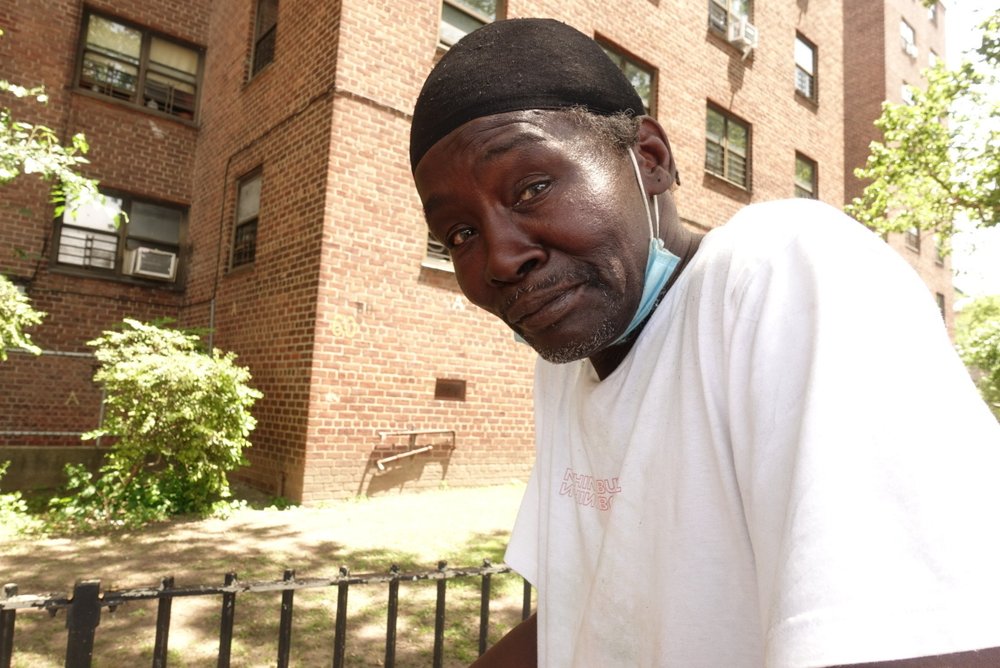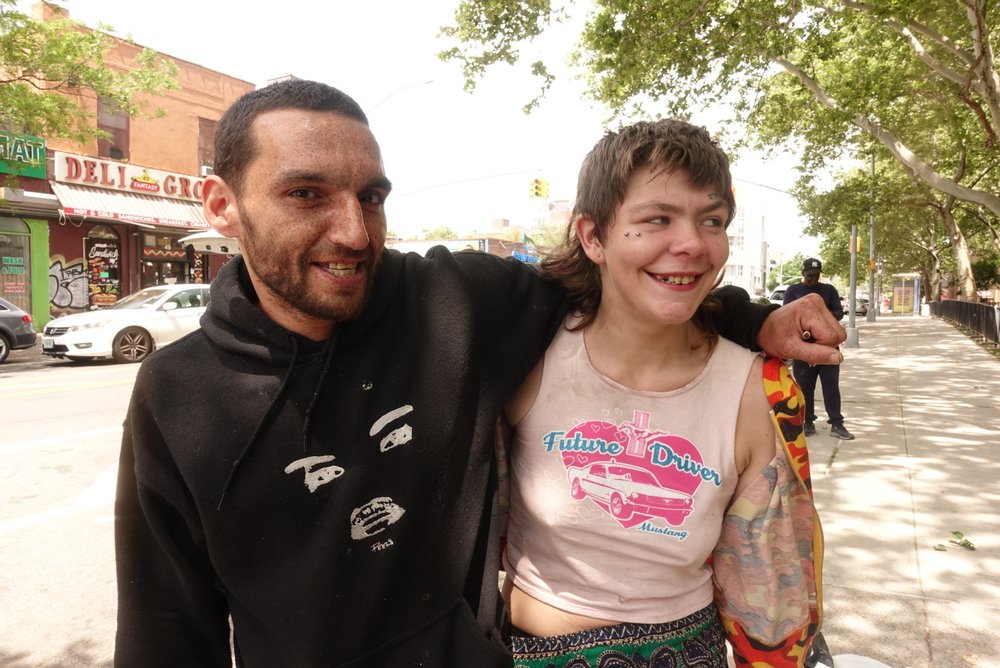City targeted same homeless New Yorkers over and over in encampment sweeps, data shows
June 9, 2022, 5:01 a.m.
“This is just bullying as municipal policy,” said Craig Hughes, a social worker with the Safety Net Project of the Urban Justice Center.

Along the grimy, pigeon-ridden underbelly of the Brooklyn-Queens Expressway that bisects North Brooklyn, you won’t find any more tents.
Around 20 homeless New Yorkers had established a string of encampments there during the pandemic, but near daily visits from police and sanitation workers over the past three months have driven the area’s former residents elsewhere.
“Now what it looks like is a parking lot,” said Benjamin Adam on a recent afternoon surveying the area.
He’s a volunteer with North Brooklyn Mutual Aid, a group that’s tried to provide food, clothes and other necessities for the area’s unsheltered population.
“There's now a sense that having a tent under the BQE will get you arrested," he said.
For Mayor Eric Adams and supporters of his efforts, that represents a success. But homeless advocates continue to rail against the tactics as inhumane, especially as most of those displaced simply end up sleeping on other streets.
This 15-block stretch under the BQE was targeted for encampment sweeps more than 60 times since the start of the year, more than any other stretch in the city, according to city data obtained through a Freedom of Information Request by the Safety Net Project of the Urban Justice Center, and shared exclusively with Gothamist.
According to the data, the sweeps were most concentrated in Lower Manhattan and North Brooklyn. City workers returned to the same encampments repeatedly, sometimes hitting a single address as many as 11 times.
Some of the people who used to live under the BQE managed to get into more stable housing situations in the fallout of the sweeps. But many more remain unhoused and, advocates argue, are more vulnerable and less able to access important services than before.
Among them is James Barnes, 65, who said he was in the hospital during one recent sweep. When he got out, all of his belongings had been tossed away.
“My clothing, my shoes, my sneakers. I lost two coats — two nice coats,” Barnes said.
Since he’d been forced away from the BQE, he’d taken to sleeping in the stairwells of the nearby public housing complex, near a highway entrance ramp and beside a gas station parking lot.
He said he would eagerly accept a safe haven bed, but so far, no one had offered him one. The special beds are typically in single rooms and offer counseling and other services.
“That sh-t don't do nothing, but make sh-t worse,” Barnes said of the encampment sweeps. “[They] make people more aggravated, more angry. Bring out that character to do sh-t that they don't want to do. You know?”
For decades, New York City mayors have deployed police and sanitation workers to break up homeless encampments. The practice ramped up in the final months of former Mayor Bill de Blasio’s tenure, despite warnings from the Centers for Disease Control and Prevention that it would further the spread of COVID-19.
Under de Blasio sanitation workers would often visit sites with homeless outreach workers, but no police. The NYPD was involved just 30 percent of the time after de Blasio withdrew them from interactions with homeless New Yorkers in the fallout of racial justice protests following the murder of George Floyd in 2020.
But once Adams’ initiative was launched in mid-March, police were present at nearly every encounter, the data shows, arriving at 708 of 726 sweeps and attempted sweeps.
Under Adams, the sweeps have occupied 660 hours of municipal employee time, not counting the hours spent when multiple workers were sent to help clear a single location. City agencies have interacted with 447 homeless people through the sweeps. It’s not clear how many times the same person was contacted, or how each encounter ended, from the data available, though sanitation workers threw out people’s belongings at least 415 times since the start of Adams’ initiative.
“This is just bullying as municipal policy,” said Craig Hughes, a social worker with the Safety Net Project of the Urban Justice Center. “No matter how many times the mayor weaponizes the term ‘dignity’ to justify this massive policing effort, there’s nothing dignified about pushing homeless people around and out of sight.”
The mayor has repeatedly defended the use of encampment sweeps insisting the city shouldn’t continue to normalize allowing New Yorkers to sleep on the streets and subways. He’s also facing pressure from business leaders as he attempts to cajole workers back to Manhattan offices — many have expressed concerns about visible homelessness and mental illness on the streets and subways.
Kathy Wylde, head of the business group Partnership for New York City, has been in close communication with Adams regarding homelessness and other issues. She said the business community is heartened by the mayor’s efforts.
“This is a much more comprehensive, strategic and consistent effort than I have ever seen, not just by the last administration, but that I've ever seen in the city,” Wylde told Gothamist. “It is a top priority for employers, because it's a top concern of their employees. That's what they're hearing — that they really want to see this done. And the employers are communicating that to City Hall and the mayor has been terrific in following up, initiating these efforts, and sustaining the outreach.”

For some people caught up in sweeps, things have improved. After a highly-publicized sweep in mid-March under the BQE, the city offered couple Parker Wolf and Mike Rodriguez each single rooms in the same safe haven shelter not too far from where they’d been living. On a recent afternoon, the pair had returned to the neighborhood to catch up with outreach workers and friends, get a meal and clean needles from an exchange.
“It’s nice eating and sleeping a lot,” Wolf said. “It's just terrible under there in the street. With all the dirt and dust and like birds and stuff under there. My lungs have cleared up significantly and I'm very glad.”
But the limited data available suggests Wolf and Rodriguez are in the minority.
Despite hundreds of encounters with homeless New Yorkers, just 39 people came indoors to either a shelter, a safe haven, or a stabilization bed via the sweeps through early May, according to the most recent tally from the mayor’s office.
The office didn’t provide an updated tally of placements through the end of May, but Charles Lutvak, a spokesperson for City Hall, pointed to previous statements that sweeps under Adams were more effective at bringing people indoors than under de Blasio. Sweeps, however, accounted for just a fraction of people sleeping on the street — nearly 1,000 people accepted some type of transitional placement last quarter, according data from the city's Social Services Department.

Nigel Jagmohan, 48, described the interactions he sees as more common: Repeated ongoing contact with various city agencies that don’t get him any closer to stable housing. On a recent afternoon, Jagmohan was laying down on the same stoop a block from Washington Square Park where city workers had found him half a dozen times before in recent weeks.
Just last Friday, he said he’d agreed to go with outreach workers to a shelter, on the promise of a single room. But when he got there, he was told there was only space in a dorm with 12 other people. He was gone within the hour.
“I had to leave, I didn’t like the energy there. They were people watching my suitcase. They be stealing your stuff,” he said.
Jagmohan met his wife under the Washington Square Park arch decades ago and when she died four years back, he set up camp a few blocks away on the stairs leading up to a rarely used emergency exit of an NYU building. He chuckled as he gestured to the latest collection of suitcases, books, mismatched shoes and clothing he’d amassed since the city's last visit in mid-May.
“Every time they come, they throw out all my stuff,” he said. “I find more stuff.”
Jaclyn Jeffrey-Wilensky contributed data analysis. This story has been updated with additional information.